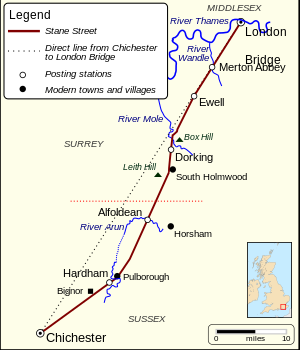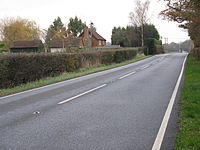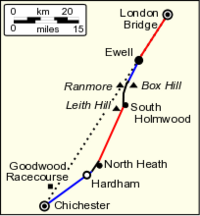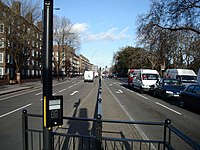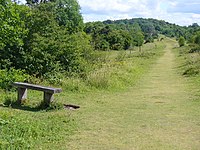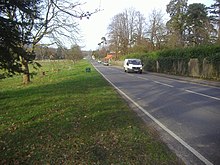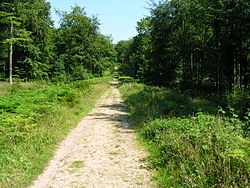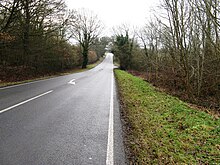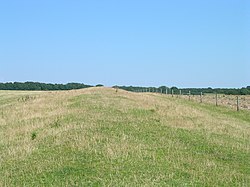Stane Street (Chichester)
- Not to be confused with Stane Street (Colchester)
Stane Street is the modern name given to an important Roman road through Surrey and Sussex, 56 miles long which linked London to the south coast town of Noviomagus Reginorum; Chichester.[1] It remained an important route long after the days of thr Romans and even today much of its route is followed by a series of A-roads through Surrey and Sussex.
The date the roadwas built is uncertain, but on the basis of archaeological artefacts discovered along the road, it was in use by AD 70[2] and may have been constructed in the first decade of the Roman occupation of Britain (as early as AD 43-53).[3]
Contents
Name
The name "Stane Street" was given to the road in Anglo-Saxon days, from the Old English Stanstræt, meaning "stone road". There is no surviving record of the name by which the road was known to the Romans.
The name of the road is first recorded as Stanstret in both the 1270 Feet of Fines and the 1279 Assizes Rolls of Ockley,[3] and is sometimes referred to as Stone Street in other mediæval sources.
Overview
A number of first-century pottery fragments and coins have been found along the road, including Samian ware of Claudian date at Pulborough. The earliest coins found are of Claudius (AD 41–54), with others of Nero, Vespasian, Titus, Domitian and Nerva (96-98 AD). This is consistent with the road being in use by AD 60 to 70, possibly earlier.[3]
Stane Street shows clearly the engineering principles that the Romans used when building roads. It follows the principal of exact straight roads, very clear from the modern map where the roads follow it, It aims straight for the Mole Gap in the North Downs, where the River Mole breaks through the Downs, and likewise natural gaps in the Greensand Ridge of the Weald to pass to the east of the high ground of Leith Hill, and again must cross the South Downs of Sussex, following the River Arun valley to Pulborough. A direct survey line between the two termini was followed for the northernmost eight miles from London to Ewell.[3] At no point does the road lie more than six miles from the direct line from London Bridge to Chichester.
Route
The Roman road is easily traceable on modern maps. Much of the route is followed by the A3 Portsmouth Road (excluding bypasses), the A24, A29 and A285, although most of the course through the Surrey downlands has either been completely abandoned or is followed only by bridleways.[4] Earthworks associated with the road are visible in many places where the course is not overlain by modern roads and the well-preserved section from Mickleham Downs to Thirty Acres Barn, Ashtead is listed as a scheduled monument.[4]
Surveying and construction
The direct line from London Bridge to Chichester passes over the North Downs at Ranmore Common, the Greensand Ridge at Holmbury St Mary and over the South Downs near Goodwood Racecourse. To cross the Downs, the Roman engineers designed the road to pass through the natural breach cut in the North Downs by the River Mole and to pass to the east of the high ground of Leith Hill. The geology of the region was also considered and the road leaves the direct line at Ewell to move onto the well-drained chalk of the North Downs, in preference to remaining on the London Clay. The road is able to make a more gentle ascent of the South Downs escarpment at Bignor than was possible at Goodwood and the chosen route avoids the need for the road to cross the steep sided River Lavant valley at East Dean.
In order to accommodate and exploit the complex topology of the region, the road used four main straight sections (sometimes referred to as limbs[5]) connected by shorter linking sections. Each limb could be surveyed separately using local vantage points.
The major limbs were:
- London Bridge to Ewell
- Ewell to Mickleham Downs
- South Holmwood to North Heath near Pulborough
- Pulborough to Chichester
The limbs were not joined directly to each other, but are linked instead by shorter segments.[3][5]
The Roman surveying technique is clearly demonstrated by the longest of the four limbs from South Holmwood to North Heath (15 miles). The line that the road follows runs between two prominent hill tops, Borough Hill on the South Downs and Brockham Warren on the North Downs.[5] There are some short local variations from the straight line of the limb, for example the Roman road loops to the west for around 200 yards at Okewood Hill to cross a small stream at a convenient fording point.[3] South of North Heath the road turns by an angle of 7 degrees to head towards the crossing of the River Arun at Pulborough. North of South Holmwood, the road turns by a further 7 degrees to the north to approach Dorking.[3][5]
The average width of the paved road is 24 feet, or 25 Roman pedes. This is wider than the average 21 feet or 22 pedes for Roman roads in Britain. The overall width between the outer ditches, which can still be seen from the air on the South Downs, is 84 feet or 86 pedes.[6] The actual width of metalling varies from place to place, and the outer ditches were found to be 90 feet apart at Westhampnet. Sections of intact road that have been excavated in several places show a variety of local materials, with the agger often being constructed of alternating layers of sand and gravel paved with large flint nodules, or sandstone, surfaced with smaller flint or sand and gravel. The metalling was generally about 12 inches thick at the centre with a pronounced camber. Near to the Alfoldean station the metalling was constructed from iron slag in a solid 12-inch thick mass.[3]
Course
Surrey: London Bridge to the Mole
The road begins in London, Roman Londinium, at London Bridge; the Roman bridge crossed the River Thames at the same place as the bridge of today. From here the line of the road is for the most part clear in the modern road pattern, running south-west through Surrey from London Bridge through Clapham and Tooting down to Colliers Wood and Merton; the A24 for the most part lies on top of it, known locally as Clapham Road and Kennington Park Road. The A264 briefly departs and Stane Street crosses the River Wandle at the site of what later became Merton Priory.
The road is then closely followed by the A24 again from Morden to Ewell. This is the only section of the road that is on the true line from London Bridge to the east gate of Chichester; The Shard, a skyscraper standing next to London Bridge, is clearly visible from certain points of London Road by looking directly up the road (northbound) between Ewell and North Cheam.
At Ewell, Stane Street is lost under modern townscape, reappearing only as it breaks out of the metropolis south-west of Epsom. From here is is no more than a mark on the ground, until south of Ashtead a bridleway adopts the routem, which continues all across Mickleham downs to Mickleham in the valley of the River Mole.
The section from Thirty Acres Barn, Ashtead to Mickleham Downs is well preserved and is listed as a scheduled monument.[4]
Surrey: The Mole to the Weald
Stane Street crossed the River Mole by a ford close to the site of the modern Burford Bridge. Excavations carried out in 1937 at the site revealed a "flint-surfaced approach to [a] ford at low level having all the signs of Roman workmanship".[7] The road passed through Dorking which was almost certainly a Roman station, although the exact course through the town is uncertain. This route takes the road east of Leith Hill; the highest hill in the south-east of Britain at 965 feet.
South of Dorking, near South Holmwood, Stane Street takes a line sighted from London Bridge, and runs straight through the farmland for sa few miles until picked up by the modern A29 north of Ockley; the road then follows the arrow-straight line of the road line through Ockley untl oakwood Hill, where the modern road veers off and the line of Stane Street again heads straight across the fields, with a footpath marking much of the route, crossing into Sussex south of Okewood Hill.
The Battle of Aclea of 851 reported in the Anglo-Saxon Chronicle[8] is thought to have been fought on this part of Stane Street, at Ockley. It would assume that the Viking army used Stane Street to march south from London towards the West Saxon capital at Winchester.
Sussex
About two miles south of the Sussex border, by the Roman station north of Slinfold, the A29 again picks up the course of Stane Street and follows it continually (bypass apart) for several miles through Sussex, through Billingshurst and as far as Pulborough.
At Pulborough the road reaches the River Arun. The A29 departs from it: the modern road avoids the hill at Rowhook, but the Roman road heads up and over.
Just to the south of the steep descent from Rowhook through Roman Woods, where the road bridged the River Arun, some of the timber piles on which the bridge was built are still present in the river bed.[9] Scattered Roman tiles and squared stone in the river bed show that stone bridge piers were built above the piling.[3] The Alfoldean station is some 30 yards south of the bridge site.
At Hardham, south-west of Pulborough, there was a junction with the Greensand Way Roman road to Lewes and a posting station near the junction. From here the alignment is a straight line for Chichester, and passes the notable Roman villa at Bignor, before making a slight detour from the line where it climbs the escarpment of the South Downs, climbing a spur of chalk at Bignortail Wood and continuing as a man made terrace across the steep hillside. This terrace is well preserved on the downhill side of the top of the modern track which leads to the hilltop car park at Bignor Hill.[10]
Up on the open heath of the downs the line of the road can be followed very well on foot and is free of modern roads and paths. Walking south from Bignor Hill one soon comes to open sheep-grazed pasture at Gumber farm where the scale of the agger of the road can be clearly seen. The spire of Chichester Cathedral can be seen above the distant trees, slightly to the right of the road line as the road heads for Chichester's east gate.
At Eartham Woods where the Monarch's Way long-distance path follows the route, the flint surface of the well-preserved road is exposed, the trees are mostly cut back to the boundary ditches, and the road seems little different from the time when the Legions left Britain.
The A285 tkes up the route north of Boxgrove and (bypass apart) takes it to the centre of Chichester.
Branch roads
The London to Brighton Way road diverged from Stane Street at Kennington Park, passing through Croydon, Godstone, Haywards Heath and Burgess Hill to cross the South Downs at Clayton.
From Rowhook a road went north-west to Farley Heath at the foot of the North Downs where it passes through a Roman temple site.
The Sussex Greensand Way branches from Stane Street at Hardham waystation, following a well-drained sandstone ridge east to Lewes.
To the north of Pulborough another road branched off in a south-easterly direction, crossing the Greensand Way at Wiggonholt. It is unclear whether it continued beyond this towards Storrington.
At Westhampnett, near the Rolls-Royce works, the Roman coastal road, which became the older A27 road, branches from Stane Street at the mini-roundabout. The Roman road continues via Broadwater, Sompting, Lancing (along a road still named The Street) and part of the Old Shoreham Road (the A270) through to Novus Portus (around modern Portslade).
Posting stations
There are two known posting stations or mansiones along Stane Street, where official messengers could change horses and travellers could rest. These are at Alfoldean and Hardham.[11] Mansiones were normally rectangular fortified sites of about 2.5 acres. The station at Alfoldean has been excavated. The Alfoldean site is just south of the River Arun and partly covered by the A29 road. It was excavated by the Channel 4 archaeological television programme Time Team, revealing the remains of a two-storey mansio built around a courtyard and also many other buildings. The site was enclosed by massive ramparts and ditches four metres wide and as deep which were dated by pottery finds to around 90 AD. The ditches were filled in by the mid-third century. The team's view was that the site had been an administrative and taxation centre for the Wealden iron industry.[12] The western side of the Hardham station was destroyed by construction of the Pulborough to Midhurst railway, but most of it, including the north and south gateways, remains.
Two further stations at Merton Priory and Dorking have been postulated as being at suitable intervals, though the sites would now be hidden under modern development.[5] Alternative sites for the posting stations have also been suggested at Ewell and Burford Bridge (where the road crossed the River Mole).[13]
Outside links
| ("Wikimedia Commons" has material about Stane Street) |
- Location map: 51°6’49"N, 0°23’7"W
References
- ↑ Vincent, Alex (2000). Roman Roads of Sussex. Middleton Press. p. 15. ISBN 1-901706-48-6. http://books.google.co.uk/books?id=g0-TPQAACAAJ&dq=Roman+Roads+of+Sussex+Vincent.
- ↑ Winbolt, SE (1936). With a Spade on Stane Street. London: Methuen.
- ↑ 3.0 3.1 3.2 3.3 3.4 3.5 3.6 3.7 3.8 I D Margary, Roman Ways in the Weald 1965 Phoenix House
- ↑ 4.0 4.1 4.2 Hall A (2008). "The archaeological evidence for the route of Stane Street from Mickleham Downs to London Road, Ewell". Surrey Archaeological Collections (Surrey Archaeological Society) 94: 225–250.
- ↑ 5.0 5.1 5.2 5.3 5.4 Belloc, H (1913). The Stane Street: A monograph. London: Constable & Co. Ltd..
- ↑ Hugh Davies Roads in Roman Britain 2002 ISBN 978-0-7524-2503-0
- ↑ The Times 25 March 1937
- ↑ Anglo-Saxon Chronicle Peterborough / Worcester Chronicle (851) þa ylcan geare com feorðe healf hund scipa on Temese muðan . . . 7 foron þa suð ofer Temese on Suðrige, 7 him þær gefeaht wið æþelwulf cyning 7 æþelbald his sunu æt Aclea mid Westseaxna fyrde, 7 þær þæt mæste wæl geslogon on hæðenum herge þæ we æfre gesæcgan hyrdon
The same year came three hundred and fifty ships into the Thames Estuary . . . and went south across the Thames into Surrey and there they fought with King Æthelwulf and Æthelbald his son at Aclea with the West Saxons' levies, and there was the greatest slaughter of the heathen army of which was ever heard tell - ↑ "Bridge Piles". Romans in Sussex. Sussex Archaeological Society. http://www.romansinsussex.co.uk/level3/search/detail.asp?maj_cat_search=communication&objectnumber=251. Retrieved 26 December 2012.
- ↑ Johnston, David E (1979). An Illustrated History of Roman Roads in Britain. Spurbooks Ltd.. p. 113. ISBN 0-904978-33-8.
- ↑ Johnston, David E (1979). An Illustrated History of Roman Roads in Britain. Spurbooks Ltd.. p. 74. ISBN 0-904978-33-8.
- ↑ Unofficial Time Team website
- ↑ Neale K (1972). "Stane Street (Chichester-London): The Third Mansio". Surrey Archaeological Collections (Surrey Archaeological Society) 69: 207–210.
Books
- Margary, Ivan D (1973). Roman Roads in Britain (3rd edition ed.). London: John Baker. pp. 64–67. ISBN 0-212-97001-1.
- Belloc, Hilaire (1913). The Stane Street : A Monograph. London: Constable (re-issued by Kessinger 2005). ISBN 1-4179-5459-0.
